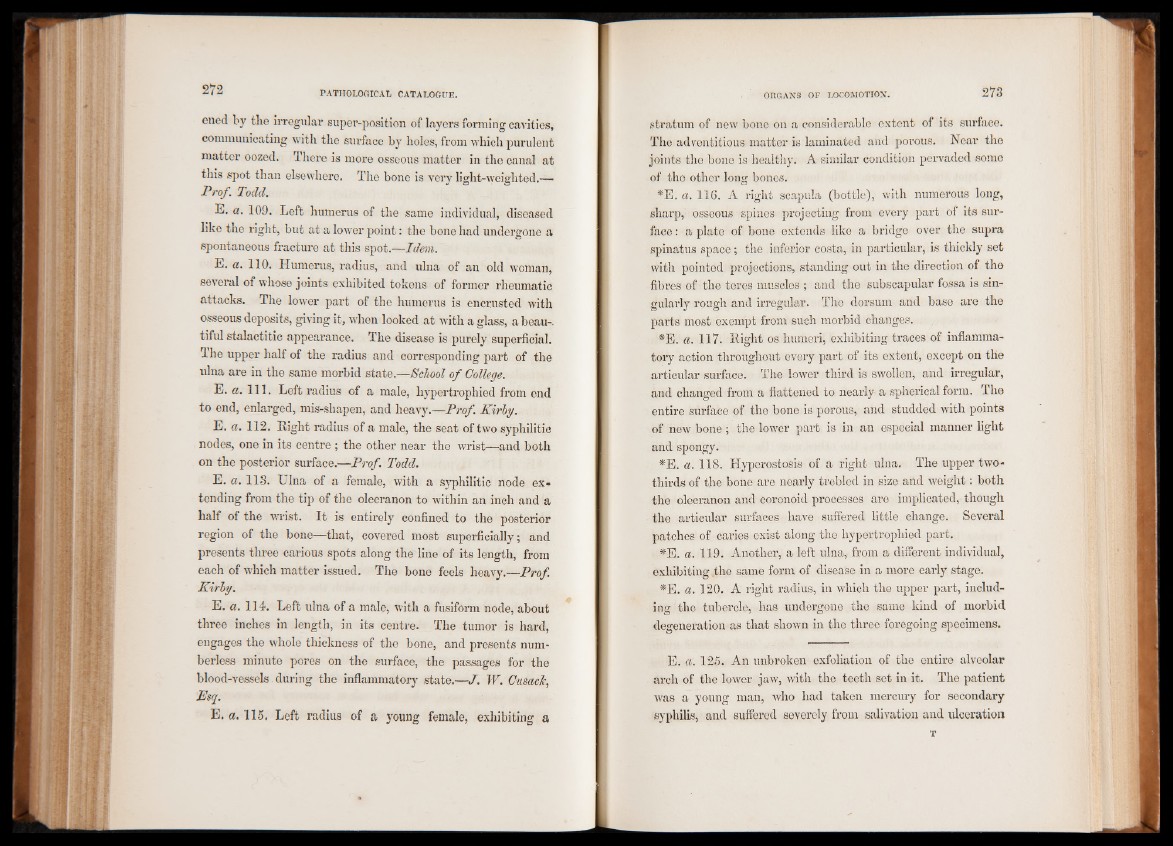
ened by the irregular super-position of layers forming cavities,
communicating with the surface by holes, from which purulent
matter oozed. There is more osseous matter in the canal at
this spot than elsewhere. The bone is very light-weighted.—
Prof. Todd.
E. a. 109. Left humerus of the same individual, diseased
like the right, but at a lower point: the bone had undergone a
spontaneous fracture at this spot.—Idem.
E. a. 1 10 . Humerus, radius, and ulna of an old woman,
several of whose joints exhibited tokens of former rheumatic
attacks. The lower part of the humerus is encrusted with
osseous deposits, giving it, when looked at with a glass, a beau-,
tiful stalactitic appearance. The disease is purely superficial.
The upper half of the radius and corresponding part of the
ulna are in the same morbid state.—School of College.
E. a. 111. Left radius of a male, hypertrophied from end
to end, enlarged, mis-shapen, and heavy.—Prof. Kirby.
E. a. 112. Right radius of a male, the seat of two syphilitic
nodes, one in its centre ; the other near the wrist—and both
on the posterior surface.—Prof. Todd.
E. a. 113. Ulna of a female, with a syphilitic node extending
from the tip of the olecranon to within an inch and a
half of the wrist. It is entirely confined to the posterior
region of the bone—that, covered most superficially; and
presents three carious spots along the line of its length, from
each of which matter issued. The bone feels heavy.—Prof.
Kirby.
E. a. 114. Left ulna of a male, with a fusiform node, about
three inches in length, in its centre. The tumor is hard,
engages the whole thickness of the bone, and presents numberless
minute pores on the surface, the passages for the
blood-vessels during the inflammatory state.—J. W. Cusack,
Esq.
E. a. 115. Left radius of a young female, exhibiting a
stratum of new bone on a considerable extent of its surface.
The adventitious matter is laminated and porous. Near the
joints the bone is healthy. A similar condition pervaded some
of the other long bones.
*E. a. 116. A right scapula (bottle), with numerous long,
sharp, osseous spines projecting from every part of its surface
: a plate of bone extends like a bridge over the supra
spinatus space ; the inferior costa, in particular, is thickly set
with pointed projections, standing out in the direction of the
fibres of the teres muscles ; and the subscapular fossa is singularly
rough and irregular. The dorsum and base are the
parts most exempt from such morbid changes.
*E. a. 117. Right os humeri, exhibiting traces of inflammatory
action throughout every part of its extent, except on the
articular surface. The lower third is swollen, and irregular,
and changed from a flattened to nearly a spherical form. The
entire surface of the bone is porous, and studded with points
of new bone ; the lower part is in an especial manner light
and spongy.
*E. a. 118. Hyperostosis of a right ulna. The upper two-
thirds of the bone are nearly trebled in size and weight: both
the olecranon and coronoid processes are implicated, though
the articular surfaces have suffered little change. Several
patches of caries exist along the hypertrophied part.
*E. a. 119. Another, a left ulna, from a different individual,
exhibiting the same form of disease in a more early stage.
*E. a. 120. A right radius, in which the upper part, including
the tubercle, has undergone the same kind of morbid
degeneration as that shown in the three foregoing specimens.
E. a. 125. An unbroken exfoliation of the entire alveolar
arch of the lower jaw, with the teeth set in it. The patient
was a young man, who had taken mercury for secondary
syphilis, and suffered severely from salivation and ulceration
T